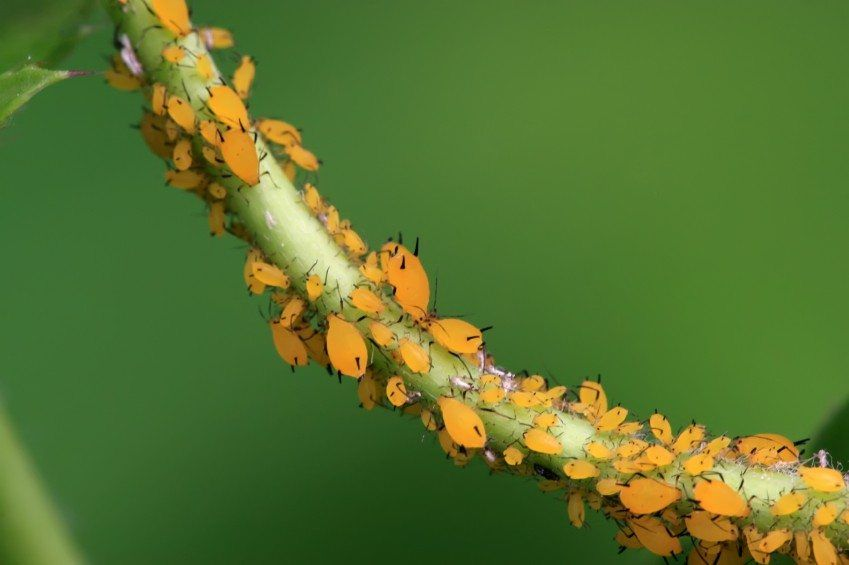Aphids are tiny sap-sucking insects in the family Aphididae. There are approximately 5,000 distinct species with hundreds of them being pests to agriculture and garden. The most common houseplant aphids tend to be light green and are known as pear aphids, but they can be colored pink, white, gray, and black. Winged aphids may also appear when colonies become adults and fly to infect new plants.


How Aphids Damage Plants
Plant owners often wonder why their plants have pests but it can be due to an Aphid infestation. Aphid infestations often build rapidly. The insects are highly mobile: they move quickly from plant to plant. Aphid colonies in the outdoor garden are usually tended by ants, which feed on aphid honeydew. It is a sugary liquid secreted by aphids as they feed on sap. Aphids spread indoors between plants by flying or crawling.
They tend to aggregate at the growing end of plants and attach themselves to the soft, green stems. New leaves look crinkled or stunted and aphids will often be visibly seen around the stem. In the worst instances, the plant will begin dropping its leaves. Finally, like mealy bugs, the honeydew produced by aphids tends to encourage the growth of sooty mold and fungus.
Instructions
Follow these instructions and get rid of Aphids easily:

1. Wash Them Away
Gently sweep them away with your fingers or a cotton swab. For smaller infestations. Cotton swabs gently wash away aphids from the inner side of the leaf.

2. Wash Them Off
A strong jet of water blows them off from the plant. If the leaves of the plant are delicate and cannot withstand spraying, you can immerse the whole plant in water to dislodge the aphids. Hold the pot upside down and dip the foliage part of the plant into a bucket with clean room-temperature water. Indoor plant rinsed under running water to remove aphids

3. Try Insecticidal Soap
Insecticidal soaps are on the market (such as Safer's Insecticidal Soap), or you can make your own by using a dish detergent such as Ivory Liquid. Mix soap with water in a low concentration by starting with 1 teaspoon per gallon adjusting accordingly to the right strength and applying sprays on plants, especially the underside of leaves. It can help kill bugs on indoor plants.

4. Spray Neem Oil
It comes from the neem tree, and it’s all organic. Follow the label instructions for the application. Insecticides from neem oil disable insects' feeding ability and repel them. Neem is safe for use on vegetables and food plants as well as ornamentals, according to the Environmental Protection Agency.

5. Making a Homemade Spray
To make a liter, put 1 bulb of garlic, 1 small onion, and 1 teaspoon of cayenne pepper into the bowl of a food processor or blender. Process until well combined into a paste. Stir the mixture into 1 quart of water. Strain through cheesecloth. Add 1 tablespoon of liquid dish soap. Mix well. This mixture can be refrigerated for up to a week. Other formulas of homemade sprays kill aphids as well.

6. Rubbing Alcohol Spray
The next step is a laborious process that kills aphids, spray a layer of it using the rubbing alcohol-soaked swab on them. Liquid antiseptic is applied between the stems of a house plant.

7. Cut Away Affected Areas
Infested parts of the plant can be cut away and taken outdoors to be disposed of. Aphid-infected stem removed from a house plant with clippers.

8. Use Sticky Traps
Sheets or strips of sticky paper hung around your plants will capture any insects that stop by. Yellow sticky trap for aphids placed next to indoor plant.

9. Use Chemical Sprays
Try low or no-chemical solutions first, but if a serious infestation of a prized plant leaves you with no other choice, treat the infestations with a spray that contains pyrethrins, imidacloprid, or pyrethroids. To minimize possible damage, try pyrethrin-based sprays, which are low in toxicity.
Keeping Aphids Away
Once you are done with the aphids, the last thing you want is for those pesky little creatures to come back, so let's quickly revisit prevention:
Keep checking your plants for pests.
Quarantine all new houseplants for a week before introducing them to your home to ensure they do not bring pests into your home.
Use Neem oil regularly to all your plants, but especially for those previously infested by pests.
Clean and quarantine houseplants that spent the summer outdoors.
How Do I Buy Plants from Eureka Farms?
Now licensed for a full-scale nursery with an extensive inventory of landscaping trees, fruit trees, palm trees, and the largest houseplant collection. If you want to enhance your curb appeal or turn your porch into a class act, Eureka Farms can guide you on how to do it all, from topiary trees and hedges to everything in between. You can rest assured that we will handle the shipment with the utmost care across the country so that when your plants reach you, they will be as fresh as new. These indoor plants require less upkeep, improve home air cleanliness, brighten moods, and provide essential touches of the natural world to the work-from-home office. Happy Planting!



